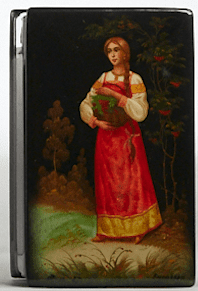
Russian Lacquerware
Interested in selling a piece of Russian art?
We have received top dollar for
Russian art. Auction is the best way to quickly and transparently get maximum dollar for your artwork.
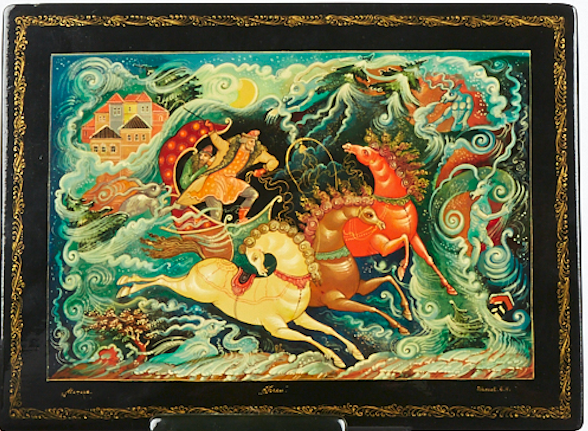
Dostoevsky’s ‘Demons’ from Mstera, for sale in September at Revere Auctions
A quick jaunt into Russian lacquerware and the transition and translation of icon painting into a Soviet approved art form
Icons to Folktales
In 1917 Russian job prospects were bleak to say the least. The revolution had begun a new era of employment insecurity for intellectuals, the clergy, and the many artists dedicated to the painting of icons both for private use and church decoration. Where were these artists to turn to in a time of extreme restriction of religious expression under the reign of nationalism? Art began to focus on the regular person, the land, and the cultural traditions of Russia, banishing the French fetishism of the fickle Tsars. With this violent turn from the gaudiness of the bourgeois and the Eastern Orthodox Church, former icon artists began to apply their skills to the painting of decorative boxes and other lacquerware depicting Russian agrarian life through genre scenes. Perhaps most beloved are the depictions of folk tales (Skazki) that taught moral lessons through gruesome curses, flying ships, Baba Yaga, and beautiful braid burdened girls saved by their own Ivan Tsarevnich.
The Four Villages
There are four recognized centers of production of lacquer art in Russian, all of these villages also once housed guilds of icon painters. These are Fedoskino, Mstera, Palekh, and Kholui. All four are situated outside of Moscow and each has its own unique painting style for lacquerware. These divergences in color, settings, thematic and stylistic elements are all continuations of the four villages’ approach to icon painting. For example, all but one of the villages (Fedoskino) use tempera paints. Some villages favor the use of gold leaf or paint to highlight certain areas of a scene, not so different from the process of painting and decorating an icon.
Fedoskino artists work in oil paints, a more precise and flexible medium as their style is based on realism or naturalism. Oils can be layered and worked with longer than tempera, allowing for more attention to detail in creating depth and texture. Their renderings of skazki were and are extremely popular.
Palekh’s use of the single color black background is yet another remnant of the icon painters, providing a contrast against the vibrant gold leaf ornamental borders. Palekh’s artists favor genre scenes of people farming, hunting, dancing, and riding sleds, as well as scenes from popular poets like Pushkin.
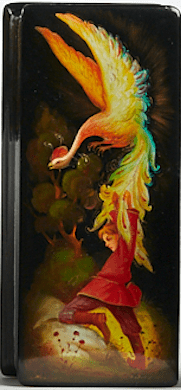
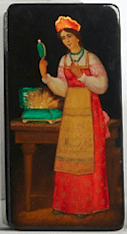

The village of Kholui does not have one set formula to its production of pieces as some boxes have a single color background while others are taken up by swirls of colors and landscapes. Not as stylistic as Palekh, Kholui’s workshops also tend to lean towards more realistic depictions. Yet they are much gaudier than Fedoskino’s reserved oil paintings with their liberal use of gold paint to outline each figure or element of a landscape.
In Mstera, figures interact directly with their landscapes rather than being framed by them. This village uses lighter colors than the other three and focuses on a more vibrant approach over all, with trees even having multi colored leaves. However their use of gold is sparing, artists usually only use it for decorative borders and other ornamental areas, it is almost never used on figures or landscapes.
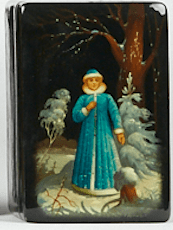
Snegurochka, for sale September 23rd at Revere Auctions
These traditional foci on theme, varying and specific uses of color, and different background types are still the dominant identifying features of each village’s wares. However, younger artists have started experimenting and straying from the well trodden paths of Soviet era stylistic conventions, providing more diversity in styles of lacquer work. More recently younger artists in the four villages have begun to revive the century long abandoned tradition of icon painting. A new market for icons has recently appeared in a Russia that has most feverishly latched itself back on to the Eastern Orthodox Church, going so far as to canonize the Romanovs.
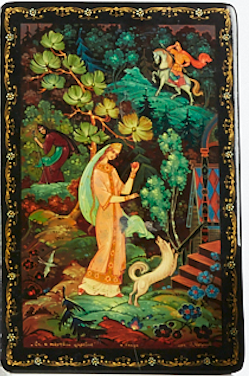
‘The 7 Knights’ from Kholui, for sale September 23rd at Revere Auctions
Making Lacquerware
When you pick up a lacquer work object that has been finely and correctly made you may remark upon the weightlessness of a box that appears to be made of solid wood. The famed lightness of these pieces comes from the fact that they are actually composed of many many layers of a thick paper mache. These layers are pressed and shaped into the desired object, be that a box, a pyxis, or a brooch. The shaping and drying process for the base takes approximately 6 weeks, but despite the longer amount of time it takes to form a paper mache base they are far less likely to warp and change the way a wood box would. The linseed oil covering also ensures that the piece is waterproof.
After the base has fully dried in an airtight oven for multiple weeks it can be covered in lacquer. Most commonly the outside lacquer is black and the inside is red, and layered until there is a smooth canvas. It is at this point that the painter receives the box and begins their process. A painting can take anywhere from a day to several months depending on the size, details, and scene itself. Once the artist has finished their delicate work the box is finally covered in a clear lacquer, sometimes up to ten coats, with each coat drying completely between each layer. This is how the smooth and shiny finish of the boxes are achieved. Some workshops have begun to use synthetic lacquers that are used on cars, the benefit being that they have no yellow tint as natural, oil based lacquers do.
In Fedoskino and Palekh the lacquer pieces are often numbered near the village name, this allows for workshops to keep track of their production throughout the year. The numbers are then reset every January. Sometimes the last name of the master painter can also be found on the box.
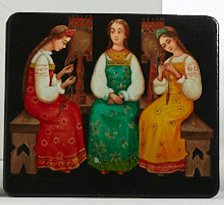
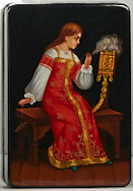
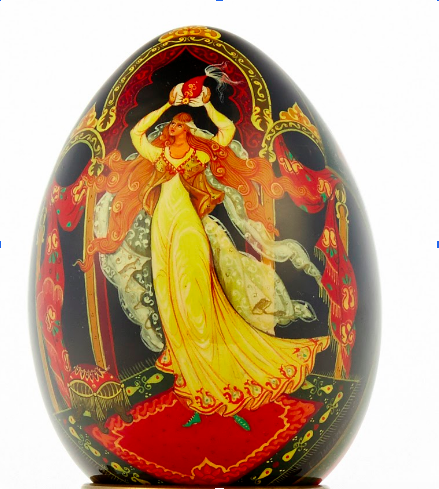
Popular Scenes
I’ve mentioned some of the favored genres of lacquer box painters, from folk tales to everyday scenes of life to landscapes, sometimes all three in one. Some of the most popular skazki depicted are ‘the Humpback Pony’, ‘the Snowmaiden’, ‘the Seven Bogatyrs (Knights)’, ‘Tsar Saltan and the Three Sisters’, ‘the Magic Mirror’, and ‘the Frog Princess’.
‘The Humpback Pony’ or ‘Ivan and the Grey Wolf’ are two stories that provide nearly perfect scenes for the artisans of Fedoskino and Palekh. The dazzling, burning feathers of the Firebird glow and radiate with halos of red, orange, and blue light against the solid black backgrounds. This creates movement in the scene as Ivan the Fool grips the huge tail feathers of the bird and attempts to snatch a single feather to fulfill his kingly quest.
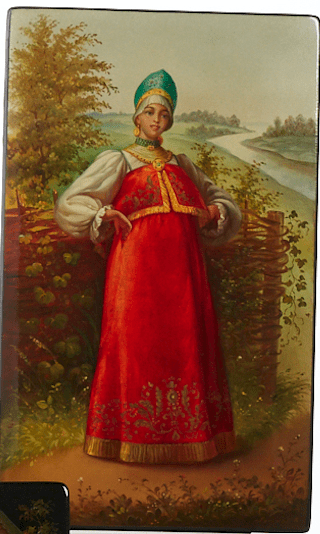
A woman in traditional Russian dress from Fedoskino, for sale September 23rd at Revere Auctions
Perhaps not as exciting as a magical story, but nonetheless beautiful, artists also paint scenes of life. There are girls entertained by musicians, a mustachioed sutor presenting gifts to woo a pretty girl. Portraits of classic Russian beauties you would find described in a Skaz are common,a Vasilisa or Varvara archetype of braids and kokoshnik glory. There are also scenes with potential double meanings, such as a girl with a woven basket overflowing with red berries: is she a symbol of agricultural abundance or is she the beautiful Marushka from the story of the 12 Months returning from the forest with her magical bounty? A girl in white fur trimmed blue robes walking through the snowy forest is almost certainly a character like Snegurochka or Nastya coming back from Morozko’s palace.
An especially intriguing box in Revere Auctions’ September 23rd sale is the one depicting a scene from Fyodor Dostoyevsky’s 1871 novel Demons. Though not a traditional folktale, Dostoyevsky uses prose to write about the instability within political and revolutionary groups of 1860s Russia, an apt topic for depiction in post 1917 Russia. The box depicts two characters being assailed by demons as they ride a troika (a three horse sleigh) through the snowy woods.

Woman with baskets of berries, or Marushka from ‘The 12 months’ from Fedoskino, for sale September 23rd at Revere Auctions
These beautiful boxes show the persistence of local artistic traditions through the upheaval of post Revolutionary Russia. They are far more than art objects–they are historical pieces of Russian artistic tradition and folk culture
If you have Russian art you wish to have appraised or sold please please get in touch for a free auction estimate.